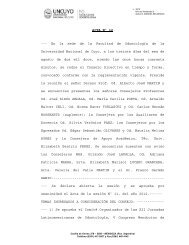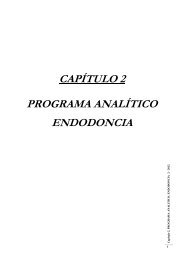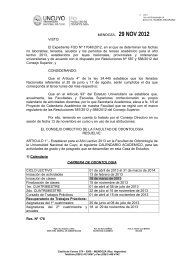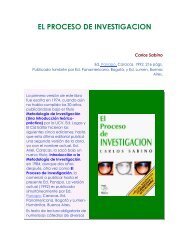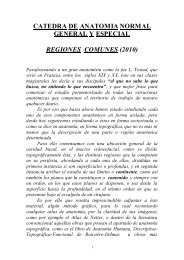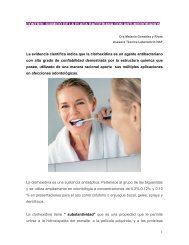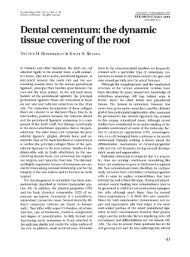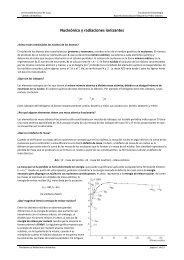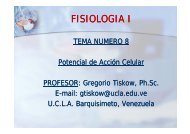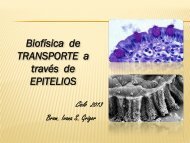A Review of Dental Suturing for Optimal Soft-Tissue Management
A Review of Dental Suturing for Optimal Soft-Tissue Management
A Review of Dental Suturing for Optimal Soft-Tissue Management
- No tags were found...
Create successful ePaper yourself
Turn your PDF publications into a flip-book with our unique Google optimized e-Paper software.
A <strong>Review</strong> <strong>of</strong> <strong>Dental</strong><strong>Suturing</strong> <strong>for</strong> <strong>Optimal</strong>S<strong>of</strong>t-<strong>Tissue</strong> <strong>Management</strong>A b s t r a c t : Establishing nontension primary wound closure <strong>of</strong> various s<strong>of</strong>ttissueflaps is paramount <strong>for</strong> optimal postsurgical wound healing. Surgicalprocedures that require clinical flap manipulation such as those used withtraditional periodontal therapy, periodontal plastic cosmetic surgery,hard- and s<strong>of</strong>t-tissue regeneration, and the excision <strong>of</strong> pathologic tissuealso require excellence in execution and thorough understanding <strong>of</strong> thevarious techniques <strong>of</strong> surgery, suturing, and the materials currently availableto ensure the desired clinical results. This article will discuss therationale <strong>of</strong> specific suturing techniques and suture materials to aid theclinician in obtaining optimal wound closure.The primary objective <strong>of</strong> dental suturing is toposition and secure surgical flaps to promoteoptimal healing (Table). When used properly,surgical sutures should hold flap edges in appositionuntil the wound has healed enough to withstand normalfunctional stresses. When the proper suture techniqueis used with the appropriate thread type anddiameter, tension is placed on the wound margins soprimary intention healing occurs. 1 Accurate apposition<strong>of</strong> surgical flaps is significant to patient com<strong>for</strong>t,hemostasis, reduction <strong>of</strong> the wound size to be repaired, and prevention <strong>of</strong>unnecessary bone destruction. If surgical wound edges are not properlyapproximated and are there<strong>for</strong>e inadequate, hemostasis is present and bloodand serum may accumulate under the flap, delaying the healing process byseparating the flap from the underlying bone. 2During the closure portion <strong>of</strong> conventional periodontal surgical therap y, the art <strong>of</strong> suturing allows <strong>for</strong> the precise positioning <strong>of</strong> the mucoperiostealflaps. For instance, certain surgical procedures, such as an excisionalnew attachment procedure (ENAP) and modified Widman flapprocedure, dictate that the surgical flaps be repositioned to their originalposition. Conversely, other periodontal procedures require that the surgicalflaps be placed in either an apical, coronal, or lateral position, dependingon the specific surgical objective <strong>of</strong> the procedure being per<strong>for</strong>med. 3In periodontal plastic, cosmetic, and reconstructive procedures,choosing the appropriate suturing technique, thread type, thread diamete r, surgical needle, and use <strong>of</strong> the proper surgical knot <strong>for</strong> each respectivethread material chosen are all critical in obtaining optimal wound healingwhen tissues are coapted over hard and/or s<strong>of</strong>t tissue, autologous orallograft material, and/or over regenerative membranes. In addition, theart and precise skill <strong>of</strong> suturing is paramount to the success <strong>of</strong> all surgicalCE 1Lee H Silverstein, DDS, MS *Associate Clinical Pr<strong>of</strong>essorDepartment <strong>of</strong> PeriodonticsMedical College <strong>of</strong> GeorgiaMarietta, GeorgiaGregori M Kurtzman, DDSAssistant Clinical Pr<strong>of</strong>essorDepartment <strong>of</strong> Restorative DentistryUniversity <strong>of</strong> MarylandBaltimore College <strong>of</strong> <strong>Dental</strong> SurgeryBaltimore, MarylandLearning Objectives:After reading this article, thereader should be able to:• describe the rationale <strong>for</strong>obtaining primary woundclosure.• discuss various types <strong>of</strong>suture needles, threadmaterial, and knots.• explain the criteria <strong>for</strong>selecting suture needles,materials, and knots.• discuss examples <strong>of</strong>absorbable and nonabsorbablesuture material.• discuss why different suturematerials and techniquesare used when suturing.*Dr. Silverstein is the author <strong>of</strong> the texbook Principles <strong>of</strong> <strong>Dental</strong> <strong>Suturing</strong>.p r o c e d u r e s . 1Vol. 26, No. 3 Compendium / March 2005 163
CE 1Table—Principles <strong>of</strong> <strong>Suturing</strong>General GuidelinesSutures are usually placed distal to the last tooth and in each interproximal space.Sutures should always be inserted through the more mobile tissue flap first.A circular <strong>for</strong>m <strong>of</strong> needle is used because <strong>of</strong> the restricted space in the mouth.Suture needles should be grasped only by needle holders and the suture needle should be inserted and pulled through the issuein line with the circ l e .Grab the suture needle in the center with the needle holder.The needle shoulder should be placed a few mm from the tip <strong>of</strong> the needle holder.Do not grab the needle at the junction <strong>of</strong> the needle and suture swaged.When penetrating through tissues, the needle should enter at right angles to the tissue.The goal during suturing multiple tissue levels is to suture periosteum to periosteum and tissue to tissue.Pull the suture just tight enough to secure the flap in place without restricting the flap’s blood supply.The flaps should not be blanched when tying a suture.Sutures should be placed no closer than 2 mm to 3 mm from the edge <strong>of</strong> the flap to prevent tearing through the flap duringpostoperative swelling.Suture MaterialsSuture ThreadThe desired qualities <strong>of</strong> a suture threadinclude the tensile strength that is appropriate<strong>for</strong> its respective use, tissue biocompatibility,ease <strong>of</strong> tying, and that it allows minimal knotslippage. It is important that the clinicianselect the specific suture thread and diameterbased on the thickness <strong>of</strong> the tissues to besutured and whether there is the presence orabsence <strong>of</strong> tension-free mobile tissues. 4There<strong>for</strong>e, it seems to this author that suturetechnique and material selection should bebased on a knowledge <strong>of</strong> the desired goals <strong>of</strong>the respective surgical procedures and thephysical and biologic characteristics <strong>of</strong> thesuture thread in relationship to the intraoral invivo healing process.The practitioner has an armamentarium <strong>of</strong>suture materials from which to select <strong>for</strong> useboth intra- and extraorally. Adequate strength<strong>of</strong> the suture material will prevent suture breakage,and proper suture knots <strong>for</strong> the materialused will prevent untimely untying or knot slippage.The clinician also must understand thenature <strong>of</strong> the suture material, the biologicprocesses <strong>of</strong> healing, the biologic <strong>for</strong>ces in thehealing wound, and the interaction <strong>of</strong> thesuture and tissues. This is vital because thepractitioner must ensure that a suture willretain its strength until the tissues <strong>of</strong> the surgicalflaps regain sufficient strength to keep thewound edges together. In those circumstancesin which the intraoral tissues most likely willnever regain their preoperative strength, or thesurgical flaps are not tension-free, the clinicianshould consider using a suture material thatretains long-term strength <strong>for</strong> up to 14 days andresorbs in 21 to 28 days, such as conventionalpolyglycolic acid (PGA) sutures. 2 , 4C o n v e r s e l y, if a suture is to be placed in atissue that heals rapidly (eg, intraoral tissue),the clinician should select a resorbable suturethat will lose its tensile strength at about thesame rate that the tissue gains strength. Thesuture also will be absorbed by the tissue so thatno <strong>for</strong>eign material remains in the wound oncethe tissue has healed, such as the surgical gut orthe new, rapidly resorbable PGA suture material(PGA-FA ) a . 1Two mechanisms <strong>of</strong> absorption result in thedegradation <strong>of</strong> absorbable sutures. First, sutures<strong>of</strong> biological origin, such as surgical gut (eg,plain and chromic gut), are gradually digestedby intraoral enzymes. 2 This suture material ismade from an animal protein and potentiallycan induce an antigenic reaction. When usedi n t r a o r a l l y, this material loses most <strong>of</strong> its tensilestrength in 24 to 48 hours, unless it is coatedwith a chromic compound that extends absorptionup to 7 to 10 days and extends loss <strong>of</strong> tensilestrength <strong>for</strong> up to 5 days. 5Second, surgical gut sutures may break toorapidly to maintain flap apposition, particularlyif used in patients with a very low intraoral pH.A decrease in intraoral pH may be caused by aplethora <strong>of</strong> physiological events, such as meta-aHu-Friedy Mfg Co, Chicago, IL 60618; (800) 483-7433164 Compendium / March 2005 Vol. 26, No. 3
Figures 1—Characteristics <strong>of</strong>simple loop suturingtechnique,CE 1Figures 2—Illustration <strong>of</strong> simple loop suture technique.Figure 3—Illustration <strong>of</strong>the “figure-eight” suturetechnique, which is mostcommonly used in thelingual <strong>of</strong> the lower molara r e a s .Figure 4—Diagram <strong>of</strong>vertical mattress suturetechnique.bolic disorders (eg, epigastric reflux, hiatal hernia,bulimia). Autoimmunity caused byS j ö g r e n ’s syndrome, chemotherapy, radiationt h e r a p y, and some medications (eg, maximumacid output inhibitors and angiotensin-convertinginhibitors, antipsychotics, diuretics,antihypertensive agents, antipsoriasis medications,and steroid inhalers) also can result indry mouth and a low intraoral pH. 2 , 6The minimum coaptation time <strong>for</strong> tissueflaps is approximately 5 days. 5 There<strong>for</strong>e, cliniciansshould select a fast-absorbing PGA suture<strong>for</strong> indications in which there is a low intraoralpH, when surgical gut sutures are contraindicated.The PGA-FA suture material is manufacturedfrom synthetic polymers and principallybroken down by hydrolysis in tissue fluids inapproximately 7 to 10 days and is not affectedby a low intraoral pH. 1,2 The PGA-FA suturealso has a higher tensile strength than surgicalgut suture material; however, it absorbs at a ratecomparable to that <strong>of</strong> surgical gut sutures undernormal intraoral physiologic conditions. 1 , 2Surgical threads, aside from being classifiedby the material they are comprised <strong>of</strong>, also areclassified by thread diameter. Thread materialsrange in diameter from 1 to 10 with the highernumber corresponding to the thinner, moredelicate thread. 7 With periodontal plasticsurgery a 5-0 thread diameter is most <strong>of</strong>ten usedto secure s<strong>of</strong>t tissue grafts and transpositional/sliding pedicle flaps, whereas a 4-0 thread isused to secure most other periodontal mucoperiostealflaps. In implant dentistry a 3-0 threaddiameter is usually used to secure flaps when amattress suturing technique is placed and thena 4-0 thread is used closer to the flap edges tocoapt the tension free flap edges. A 4-0 threadalso is used to secure implant surgical flapswhen interrupted, some mattress sutures, andmost continuous suture techniques have beenp e r f o r m e d .Surgical threads also are fabricated to beeither natural or synthetic nonresorbable materials.Classically, silk has been the most universallyused material in dentistry and many othersurgical disciplines. 8 In this author’s experience,silk is easy to handle, ties with a slip knot,and is relatively inexpensive compared withother nonabsorbable suture materials currentlyavailable. However, there are distinct disadvantageswhen using silk. First, it is nonabsorbableso must be removed, usually a week or so laterwhen the patient is not numb. Second, silkspecifically is a multifilament that “wicks” orpulls bacteria and fluids into the wound site. 9There<strong>for</strong>e, in this author’s opinion, silk is notthe suture material <strong>of</strong> choice when any sterilematerials are placed under a mucoperiostealflap (eg, dental implant, bone graft, or regenerativebarrier) or when there is clinical evidence<strong>of</strong> an infection at the surgical site. Instead <strong>of</strong>Vol. 26, No. 3 Compendium / March 2005165
CE 1Figure 5—Diagram<strong>of</strong> apically repositionedvertical mattresssuture technique.Figure 6—Diagram<strong>of</strong> vertical sling mattresssuture technique,which is used<strong>for</strong> predictable interdentalclosure followingan interdental/interimplantboneregenerative procedure.Figure 7—Clinical photograph illustrating a sling suture in themaxillary anterior region following the placement <strong>of</strong> a connectivetissue graft over a dental implant to s<strong>of</strong>t tissue root convexity.silk, there are other nonabsorbable sutures thatcan be used in these situations, such as nylon,p o l y e s t e r, polyethylene, polypropylene, orexpanded polytetrafluoroethylene (e-PTFE).Polyester sutures are comprised <strong>of</strong> multifilamentsthat are braided into a single strand.This suture is made <strong>of</strong> a polyethylene polymerand does not weaken when moistened and hasa lot <strong>of</strong> tensile strength. The polyester suturesare usually coated with a biologically inert n o n-absorbable compound, which aids the suture inpassing more easily through tissues. This coating,h o w e v e r, does present a problem in that it alsomakes knot security an issue because the materialwill easily untie if not secured with a surgeon’sk n o t . 4 The e-PTFE suture material is a nonabsorbablemon<strong>of</strong>ilament that has high tensilestrength, good handling properties, and goodknot security, but is expensive compared with allthe other nonresorbable suture materials. 1NeedlesAside from the thread type, the otherimportant component <strong>of</strong> a suture is the needle.The surgical needle is comprised <strong>of</strong> 3 parts: theneedle point, the needle bod y, and the swaged(press-fit) end. Suture needles usually are classifiedaccording to their curvature, radius, andshape. The most commonly used suture needlesin dentistry are the 3/8 and 1/2 circle needles. 3 , 4The 3/8 needle allows the clinician to pass fromthe buccal surface to the lingual surface in onemotion. In contrast, the 1/2 circle needle is traditionallyused in more restricted areas; <strong>for</strong>instance, in the buccal <strong>of</strong> the maxillary molarsand the facial aspect <strong>of</strong> the maxillary andmandibular incisors. In addition, the 1/2 circleneedle is routinely used <strong>for</strong> periosteal andmucogingival surgery. 1 - 4Suture needles also are classified as eitherconventional cutting or reverse cutting. 5 I nd e n t i s t r y, the clinician always should usereverse cutting sutures to prevent the suturematerial from tearing through the papillae orsurgical flap edges, which is referred to as “cutout.” Usually, a cut out is caused by a conventionalsuture needle because it has an insideconcave curvature that is sharpened, whereas areverse cutting needle has a smooth inner curvatureand its third cutting edge is located onits convex (outer) edge. 4 Generally in dentistry,the 3/8 reverse cutting needle with a 3-0 or 4-0thread diameter and the 1/2 reverse cuttingneedle with the thinner and more delicate 5-0or 6-0 thread diameter are the most commonlyused needle and thread combinations, accordingto the author’s private communicationswith suture manufacturers.KnotsSurgical knot tying is an important componentto the art <strong>of</strong> suturing. It is essential <strong>for</strong> knotsecurity and to obviate untimely knot untyingthat the appropriate surgical knot be used <strong>for</strong> thespecific suture material being secured. Forinstance, when using silk, e-PTFE, chromic gut,or plain gut suture material, a slip (granny) surgicalknot should be used. However, with the166 Compendium / March 2005 Vol. 26, No. 3
CE 1knowledge with regard to the various types <strong>of</strong>suturing armamentarium available to assist inobtaining optimal wound closure. The success<strong>of</strong> technique-sensitive procedures such as conventionalperiodontal therapy, dental implanttherapy, mucogingival microsurgery, periodontalcosmetic plastic surgery, regeneration <strong>of</strong>hard and/or s<strong>of</strong>t tissue, and excisional treatment<strong>of</strong> pathologic tissue depends on the clinician’sknowledge and skill <strong>of</strong> executing propersuturing <strong>for</strong> optimal wound closure.The recent innovations in suturing materialsnot only eliminate some <strong>of</strong> the difficultiespreviously encountered during surgicalclosure, but also decrease the potential <strong>for</strong>postoperative infections.AcknowledgmentSpecial thanks to David Kurtzman, DDS, acosmetic dentist located in Marietta, Georgia,<strong>for</strong> his beautiful illustrations.References1. Silverstein LH. Essential principles <strong>of</strong> dental suturing <strong>for</strong> theimplant surgeon. Dent Implantol Update. 2005;16(1):1-7.2. Silverstein LH. Suture selection <strong>for</strong> optimal flap closureand tissue healing. Perio-implant showcase. Pract PerioAesthet Dent. 2005;16:2-3.3. Cohen ES. Sutures and suturing. In: Atlas <strong>of</strong> CosmeticReconstructive Periodontal Surgery. 2nd ed. Philadelphia:Lea & Febiger; 1994:9-30.4. Silverstein LH. Principles <strong>of</strong> <strong>Dental</strong> <strong>Suturing</strong>: The CompleteGuide to Surgical Closure. Mahwah, NJ: Montage Media;1999.5. Wound Closure Manual, Somerville, NJ: Ethicon Inc;1985:1-101.6. Lilly GE, Salem JE, Armstrong JH, et al. Reaction <strong>of</strong> oraltissues to suture materials. 3. Oral Surg Oral Med OralPathol. 1969;28:432-438.7. Meyer RB, Antonin CJ. A review <strong>of</strong> suture materials, partI. Compend Contin Educ Dent. 1989;10:260-264.8. Macht SD, Krizek TJ. Sutures and suturing—current concepts.J Oral Surg. 1978;36:710-712.9. Manor A, Kaffe I. Unusual <strong>for</strong>eign body reaction to a braidedsilk suture: a case report. J Periodontol. 1 9 8 1 ; 5 3 : 8 6 - 8 8 .10. Mejias JE, Griffin TJ. The absorbable synthetic sutures.Compend Cont Educ Dent. 1983;4:567-572.11. Hutchens LH. Periodontal suturing: a review <strong>of</strong> needles,materials and techniques. Postgrad Dent. 1995;2(4):1-15.168 Compendium / March 2005 Vol. 26, No. 3
Quiz11. When proper suture techniqueis used with the appropriatethread type and diameter, tensionis placed on the woundmargins so:a. primary intention healingoccurs.b. secondary intention healingoccurs.c. tertiary intention healingoccurs.d. the knot is directly over theincision.2. In those circumstances inwhich the intraoral tissues mostlikely will never regain theirpreoperative strength, the clinicianshould consider using asuture material that retainslong-term strength <strong>for</strong> up to:a. 7 days.b. 14 days.c. 21 days.d. 28 days.3. If a suture is to be placed in atissue that heals rapidly, theclinician should select aresorbable suture that will loseits tensile strength at:a. 7 days.b. 14 days.c. 21 days.d. about the same rate that thetissue gains strength.4. Sutures <strong>of</strong> biologic origin are:a. nonantigenic.b. gradually digested by intraoralenzymes.c. made from human protein.d. easy to tie knots in.5. Surgical gut sutures may breaktoo rapidly to maintain flapapposition, particularly if usedin patients with:a. very low intraoral pH.b. very small flaps.c. large tongues.d. Class III malocclusion.6. The minimum coaptation time<strong>for</strong> tissue flaps is approximately:a. 1 day.b. 3 days.c. 5 days.d. 7 days.7. Pulling bacteria and fluids intothe wound site is called:a. repopulating.b. bonding.c. wicking.d. delaminating.8. A cut out is caused by a conventionalsuture needle becauseit has:a. a very large radius.b. a very small radius.c. an inside concave curvaturethat is sharpened.d. an outside concave curvaturethat is sharpened.9. The type <strong>of</strong> knot that is used<strong>for</strong> each material is determinedby the mode in which:a. each type <strong>of</strong> thread is manufactured.b. the attached gingival will beapproximated.c. the unattached gingival willbe approximated.d. oral fluids degrade it.10. When per<strong>for</strong>ming a mattresssuture, the needle penetrationthrough the surgical flap shouldbe how far away from the flapedge?a. 1 mm to 2 mmb. 3 mm to 4 mmc. 5 mm to 6 mmd. 8 mm to 10 mmThis article provides 1 hour <strong>of</strong> CE credit from Ascend Media’s <strong>Dental</strong> Learning Systems, in association with the University <strong>of</strong>Southern Cali<strong>for</strong>nia School <strong>of</strong> Dentistry and the University <strong>of</strong> Pennsylvania School <strong>of</strong> <strong>Dental</strong> Medicine, representatives <strong>of</strong> whichhave reviewed the articles in this issue <strong>for</strong> acceptance. Record your answers on the enclosed answer sheet or submit them on a separatesheet <strong>of</strong> paper. You may also phone your answers in to (888) 596-4605 or fax them to (703) 404-1801. Be sure to include yourname, address, telephone number, and social security number.Vol. 26, No. 3 Compendium / March 2005169



